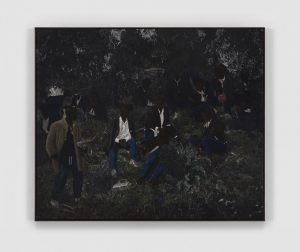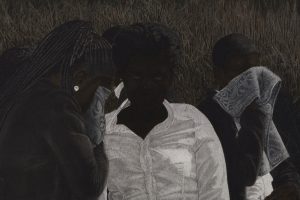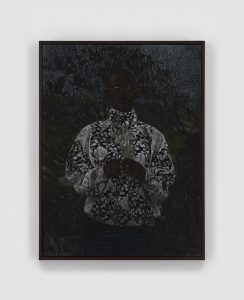The FLAG Art Foundation, founded in 2008 by the patron Glenn Fuhrman, is a non-profit institution with the aim of spreading contemporary art to a wider and not just specialist public. Four to six exhibitions a year are presented, including works by established and emerging international artists, relying on external contributions in planning its work and providing curatorial support and a support platform for younger artists to carry out their first exhibitions. FLAG’s innovative approach to fostering dialogue around contemporary art includes organizing artist meetings, artist-led workshops and exhibition tours for school and museum groups, while also facilitating loans of contemporary art to museums and galleries around the world, thanks to the support of a large database of works kept available to curators.
The inaugural exhibition, in 2008, “Attention to Detail”, curated by Chuck Close (Monroe 1940, New York 2021), presented the works of fifty artists, all concentrated on a high degree of conceptual and technical precision. Which, knowing the work of Close (the poet of the large-scale photorealistic portrait), is completely understandable and legitimate, given that precisely with respect to his own work he had stated: “I am looking for a level of perfection that is mine alone … most of the pleasure is in making the last little piece perfect”. Or, to put it in the words of many architects or furniture craftsmen, the value of a work lies in the detail, in the small detail. Among the artists invited to that first great event we remember the names of Franz Gertsch, Robert Gober, Brice Marden, Ron Mueck, Marc Quinn, Thomas Struth. At the beginning of its activity, FLAG presented almost fifty exhibitions, for a total of more than five hundred established or emerging international artists. In more recent times, the program has been expanded to focus on the work of individual artists, such as Ashley Bickerton, Patricia Cronin and Cynthia Daignault. It should also be noted that The FLAG Art Foundation does not have a permanent collection as it operates in the spirit of a Kunsthalle, borrowing works from a variety of sources, including artists, private collections, galleries and museums.
Now, since October 16, the Foundation hosts a solo show by Cinga Samson (born in Cape Town, South Africa, in 1968, lives in Cape Town), with about twenty oil paintings dealing with the theme of violence, referring not only to explicit brutality, but also to those moments of aggression, outrage, insult, brutality, ferocity, coercion, mistreatment that hide and are beyond our field of vision or that hide inside the home. The works are performed with a mixture of traditional techniques that see the overlapping of oil painting with material experimentation, so much so that we can affirm with extreme certainty that his work becomes a new and authoritative voice of contemporary painting. A narrative painting that wants to underline the desire for African identity and beauty and the celebration of one’s world, one’s history, one’s customs and ancestral legacies that cannot be erased with the brush of progress, because, as the author, a few years ago with a bit of healthy pride: “My work is a celebration and I firmly believe that Africans are beautiful people”.
Ultimately, Cinga Samson’s paintings lay bare the complex relationship between contemporary life, African traditions, globalization, memory and spirituality. The fact that most of his subjects are focused on the exaltation of the body of black men may lead to a comparison with the work of the great portrait painter Kehinde Wiley, but while in Wiley there is an almost decorative aspect to provide the background and to enhance the individual figures with even realistic precision, in Samson the identity politics becomes a choral discourse: a mixture of bodies that often in the dark and dark pigment (in the depth of the black color it is to be said, almost out of desire for tautology) not only cancel the detail of the environment, but often also every single physiognomy. Quoting the title of one of his exhibitions a few years ago, we could conclude: “Men are different even if they look alike”, because – as Émile Zola already observed – “art is a fragment of nature filtered by character”. Samson’s work rose to the international stage thanks to his solo show, in 2020, at the Galerie Perrotin in New York; from there the step for participation in art fairs and group exhibitions and contacts with galleries was really short. To join the online conversation: Instagram (@flagartfoundation) and Twitter (@FLAGartNYC), hashtag #CingaSamson
Bruno Purek
Info:
Cinga Samson, Iyabanda Intsimbi / The Metal is Cold
16/10/2021 – 15/01/2022
The FLAG Art Foundation
545 West 25th Street, 9th Floor
New York, NY 10001
email: info@flagartfoundation.org
phone: (212) 206-0220
 Cinga Samson, Umkhusana 2, 2021, oil on canvas, 220 x 260 cm. © Cinga Samson. Photo © White Cube (Nina Lieska | ARTREPRO)
Cinga Samson, Umkhusana 2, 2021, oil on canvas, 220 x 260 cm. © Cinga Samson. Photo © White Cube (Nina Lieska | ARTREPRO)
 Cinga Samson, Umkhusana 1, 2021, detail. © Cinga Samson. Photo © White Cube (Nina Lieska | ARTREPRO)
Cinga Samson, Umkhusana 1, 2021, detail. © Cinga Samson. Photo © White Cube (Nina Lieska | ARTREPRO)
 Cinga Samson, Okwe Nkunzana 6, 2021, oil on canvas, 80 x 60 cm. © Cinga Samson. Photo © White Cube (Nina Lieska | ARTREPRO)
Cinga Samson, Okwe Nkunzana 6, 2021, oil on canvas, 80 x 60 cm. © Cinga Samson. Photo © White Cube (Nina Lieska | ARTREPRO)

is a contemporary art magazine since 1980






NO COMMENT